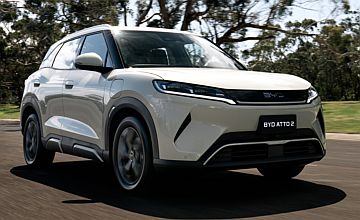Make / Model Search
OptionsCar reviews - BYD - Atto 2BYD modelsOverviewWe like Efficiency, plush ride, manoeuvrability, prompt acceleration, refinement, spacious back seat, relatively simple HMI, affordable entry grade, well-equipped $36K Premium Room for improvement Hypersensitive audible lane and speed warnings, hybrid version not yet locked in, glacial DC charge rate, mileage-limited warranty, country roads reveal underdamped nature BYD Atto 2 cheapest BEV Down Under… for now20 Nov 2025 By TOM BAKER Overview
LEADING Chinese carmaker Build Your Dreams has matured since entering Australia in 2022—a quality seen in decisions to abbreviate branding to BYD, dial down quirkiness, improve ride and handling, add hybrid powertrains and, latterly, a switch to a factory-imported business model.
National sales company BYD Australia is now moving to plug gaps in the carmaker’s local lineup as it steels itself for a shot at a top-five slot in Australia’s new car market. It has already surged past MG to become the leading Chinese marque in Australia with 41,882 sales YTD.
BYD came to Australia as a battery electric (BEV) brand but crucially, half this year’s deliveries have been plug-in hybrids (PHEVs), led by the Shark 6 ute (15,181) and Sealion 6 midsize SUV (7453), though the brand’s BEVs including the Sealion 7 crossover (9824) are performing.
With 50,000 sales the end-of-year goal for BYD, the stage is now set for the arrival of two new price-leading models in the Atto 1 hatch and Atto 2 small SUV which, while not expected to overwhelm the big sellers, are seen as important fulfilment of BYD’s promise to sell in all segments.
Examples of the pint-sized Atto 1 (from $23,990 plus on-road costs) are still on water to Australia but customer deliveries of the plainly-styled but cosmetically inoffensive Atto 2 (from $31,990 + ORCs) have kicked off.
For now, the base Atto 2 Dynamic is Australia’s cheapest electric SUV, though we expect competition to remain hot in this part of the market.
Overseas, the Atto 2 is built in BEV and PHEV formats. While the hybrid is very likely to come to Australia, two electric variants are first to arrive, each sporting a 130kW/290 front motor, 51.1kWh lithium iron phosphate ‘Blade’ battery built in-house, heat pump and all-round disc brakes.
Mechanically, it’s a simple package with MacPherson strut-type front suspension, a torsion beam around back and smallish wheels, with the $32K Dynamic wearing 215/65 R16 ‘Westlake’ rubber. The $36K Premium upgrades to 215/60 R17 Hankooks but is otherwise identical from below.
Standard kit is reasonable, with Dynamic packing vinyl seating (manually adjusted), a four-speaker stereo, climate control with rear air vents, LED headlights, digital key/connectivity, 10.1/8.8-inch displays, wireless Apple CarPlay/Android Auto, FB/DAB radio only and automatic wipers.
Premium spec’ adds valuable conveniences like power driver’s seat adjust, heating/cooling for the front pews, a punchier eight-speaker stereo, roof racks, heated/dimming mirrors and a glass roof with sunshade.
Four colours are available with three metallics priced at $600 while solid Ski White is the included colour. Warranty coverage is six years/150,000km for the car and eight years/160,000km for the battery. Service pricing is yet to be determined by BYD Australia.
Efficiency is claimed to be 14.8kWh/100km for WLTP range of 345km. The Atto 2 packs only a single-phase 7kW AC onboard charger while DC charging is limited to 82kW peak, with a 10-80 per cent session requiring 39 minutes (averaging 55kW across that session).
Driving impressions
Our week-long initial test of the Atto 2 saw the 4310mm-long, 1830mm-wide and 1675mm-high small SUV contender pressed into daily driving that included commuting in Sydney, traversing Hunter Valley country roads and sitting at 110km/h on the M1 Newcastle motorway.
It’s commuting where the BYD is happiest, but its reasonable footprint and middleweight 1555-1590kg kerb weight makes it a stable and planted companion for freeway stints, even if these are somewhat limited by the SUV’s modest driving range.
And it is modest even if efficiency was a standout. We beat BYD’s claims, returning 14.2kWh/100km on an equally balanced loop (359km range), falling to 13.6kWh/100km when used only in the ‘burbs (375km). Still, some will want to hold out for a 1000km-range Atto 2 PHEV.
Really, the only Australian driving environment where the Atto 2 feels a touch out of its depth is our winding, poorly surfaced country roads. Here, the limits of the torsion-bar rear are evident, as is the ultimately under-damped suspension tune, which can pogo once or twice over bumps.
These effects are technically still detectable elsewhere, but their import dies off when you’re pootling or commuting. The daily grind shows an upside to the BYD’s very soft ride: it’s downright plush over urban imperfections, making sportily tuned SUVs seem indulgent by contrast.
A tight 5.25m turning circle, quick, fluid and light steering and excellent outward visibility (backed by a crisp 360-degree camera in the Premium) make the Atto 2 remarkably manoeuvrable and it’s reasonably satisfying to drive in its own way.
Compared to conventionally powered small SUVs, the electric Atto 2 is also quite a revelation in refinement. Without an underpowered petrol mill and elastic CVT, progress from the 130kW motor comes gently but promptly and the Atto 2 generally noses ahead of dozier traffic.
Two levels of regenerative braking offer a degree of customisation though there is no true one-pedal drive mode for those that prefer it.
BYD says that the cell-to-battery construction of the Atto 2, which integrates the traction battery into the chassis—the top of the pack is the passenger floor—improves rigidity. From our perspective, no creaks or rattles were forthcoming while flex did feel minimal.
Drive gracefully and the only irritant is overbearing speed monitor beeps and lane-keep steering intervention. Frustratingly (and unnecessarily) both functions restart with every ‘ignition’ and it takes around 10 taps total to disable all of them at once. A shortcut would be a nice upgrade.
Other than those noises, there’s not much to hear inside, at least until wind rushing over the side mirrors becomes evident around highway speed. The cabin is hushed, though some motor whine can be picked up.
From the two launch grades, the Atto 2 sweet spot is the Premium spec. It doesn’t grab headlines with the Dynamic’s segment-leading price point, but the Premium’s added luxuries (particularly ventilated seats in summer) make a meaningful quality-of-life difference and are worth it.
The Atto 2’s no-nonsense interior styling (in relatively dour black/dark grey colours) appears to be a snapback against mixed reception to the larger Atto 3’s, er, ‘characterful’ cabin decoration, which was said to be reminiscent of muscle tissue, sinew and…gymnasium barbells. OK!
By contrast, the Atto 2 keeps things sensible and key functions are in expected positions, mainly with physical hotkeys (volume, regen’, drive mode, start/stop) or snappy soft controls (such as the permanent climate bar on the central touchscreen).
Improvement is needed for front seat comfort, as the lack of thigh tilt-angle adjustment means longer-legged folk aren’t well catered-to, though back seat room is excellent thanks to a relatively long wheelbase and smart packaging. Boot space of 380L is also solid for the class.
It will be interesting to watch the sales performance of the Atto 2. There is little doubt that the addition of a PHEV version will boost this BYD’s appeal (and potentially even lower its price further), but the BEV variants will benefit from some very cheap novated lease deals.
The arrival of the Atto 2 at relatively low price of entry (in either grade) will allow the salary-packaging firms to market very low weekly prices for fully maintained operating leases of the BYD—and this may well create quite a bit of demand where there appears to be little now.
 All car reviews Alfa Romeo Alfa Romeo Abarth Abarth Audi Audi Aston Martin Aston Martin BMW BMW Bentley Bentley Chrysler Chrysler Chevrolet Chevrolet Dodge Dodge Citroen Citroen Ferrari Ferrari DS DS Ford Ford Fiat Fiat FPV FPV Foton Foton Haval Haval Great Wall Great Wall Honda Honda Holden Holden Hyundai Hyundai HSV HSV Isuzu Isuzu Infiniti Infiniti Jaguar Jaguar Iveco Iveco Kia Kia Jeep Jeep Land Rover Land Rover Lamborghini Lamborghini Maserati Maserati Lexus Lexus McLaren McLaren Mazda Mazda Mercedes-Benz Mercedes-Benz Mitsubishi Mitsubishi Mini Mini Opel Opel Nissan Nissan Porsche Porsche Peugeot Peugeot Ram Ram Proton Proton Rolls-Royce Rolls-Royce Renault Renault Skoda Skoda Saab Saab SsangYong SsangYong Smart Smart Suzuki Suzuki Subaru Subaru Toyota Toyota Tesla Tesla Volvo Volvo |
OptionsClick to share
|









Facebook Twitter Instagram